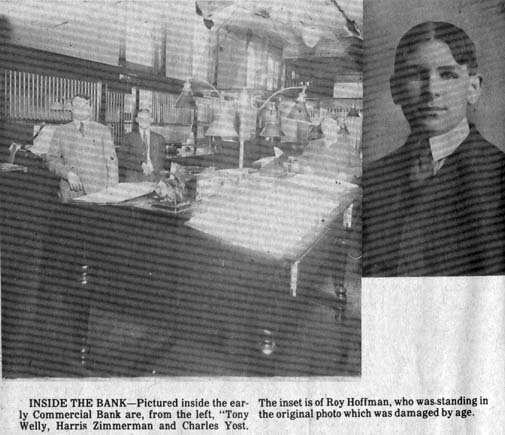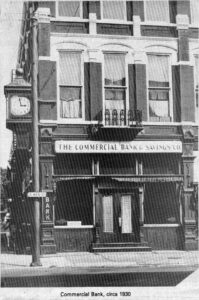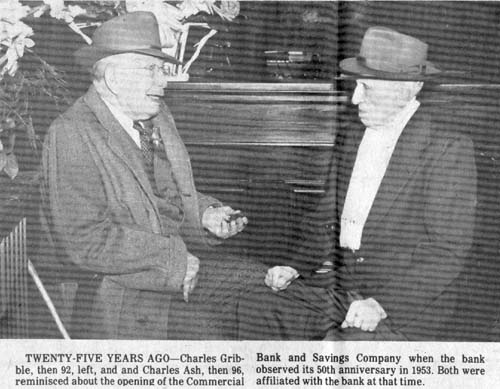July 6, 1978



Picture #1 – Inside the bank – Pictured inside the early Commercial Bank are, from left, “Tony Welly, Harris Zimmerman and Charles Yost”. The inset is of Roy Hoffman, who was standing in the original photo which was damaged by age.
Picture #2 – Commercial Bank, circa 1930
Picture #3 – Twenty Five Years ago – Charles Gribble, then 92, left and Charles Ash, then 96, reminisced about the opening of the Commercial Bank and Savings Company when the bank observed its 50th anniversary in 1953. Both were affiliated with the bank at that time.
This year is the 75th anniversary of The Commercial Bank and Savings Company here in Fostoria.
Passing the branch-office at Main and Tiffin streets the window shoppers will see an oversize birthday cake (not for eating), reminding Fostorians of the bank’s age.
Other activities in town have declared the special year, including the bank’s own promotional and advertising activities; also a tribute to the financial institution was staged recently by the Chamber of Commerce.
All of those expressions are only the tip of the iceberg, so to speak. The real story of the 75 years of the bank’s activities in this area is told in the historical notes, buried in the scrapbooks, yellow with age…and in the minds of those who have been associated with the institution in one way or another. One of those is Roy Hoffman…the only one still living who was an employee during the early days.
THE EARLY DAYS
At its 50-year point, the bank published its annual statement; also a brief history of the bank’s founding, and first officers, from which I quote:
“In 1902, a group of prominent businessmen and farmers in this community, with an abiding faith in the future of Fostoria, and being convinced that a real need existed for another sound and progressive bank to serve the people of this area, organized the third financial institution of this city, The Commercial Bank and Savings Company. A charter was issued by the State of Ohio on October 23, 1902, and on November 5, 1902, the organization was completed by the election of directors: E.J. Cunningham, Charles Ash, W.H. Jones, John E. Finsel, R.D. Sneath, N. Saltsman, C. German, Theo Wentz, John Noble. Officers elected were President, E.J. Cunningham; V. President, Charles Ash, Cashier, J.D. McDonel; Asst. Cashier, Charles Gribble.
E.J. Cunningham was connected with the Stave and Barrel Works and principal owner for many years. Charles Ash was a farmer and Treasurer of Seneca Co. C. German was a realtor, J.D. McDonel was in the men’s clothing business and also connected with the development of the TF and F and F interurbans. Charles Gribble had a photographic studio.
R.D. Sneath was a Tiffin businessman. The professions of the others in the above list are unknown by the author.
Cunningham was president for only two years, when he died. He was succeeded by Charles Ash, who held that position until 1932, when he became chairman of the board.
Although the new bank was granted a charter in 1902, it was actually March 23, 1903, before a location was selected and the doors were opened for business. The location was the corner of Main and Tiffin, where it continued in business for more than 50 years and where the uptown branch is still located. It was the same location where The Foster and Co. Bank, headed by Charles Foster, one of Fostoria’s pioneers did business until it failed in 1893.
The new bank was capitalized for $50,000 and a surplus of $10,000 small sums in comparison with the figures today.
Ash became president in 1905, and Gribble became cashier.
Roy Hoffman joined the bank as bookkeeper in 1911. He had previously been associated with A. Weaver and Sons dry goods store.
Banking practices were far different then as compared to today, according to Hoffman. The one accompanying photo depicts what the bank interior looked like then. Note the high sloping desk that held the oversize entry journals. ..also the quaint lights. “We had one hand-operated adding machine… bookkeeping was all done by hand…no computers then”, he continued.
BANK HOLIDAY
I asked Hoffman what was the most important event he remembered in his 45 years with the bank. He reflected only briefly, then said, “the bank holiday in 1930”. “And just how did it affect the bank, and what did you have to do”, I asked.
“First of all”, he replied, “I had to make a complete list of all our customers with savings and checking accounts and certificates. I don’t remember the exact figures, but they were permitted to draw a percentage of their money”. Hoffman said there was no great “run” on the bank and no customer ever lost a penny of their money. Some bank customers were not so fortunate.
Lucian Kinn, father of Frank J. Kinn, the current president of the bank was appointed referee of the bank at the time of the bank holiday. He later became the president, following Charles Ash.
CONTINUED GROWTH
From the time the Commercial Bank was started in 1903, it continued to grow. The founders were correct in their belief that the community needed a third bank.
By the end of the first year of operation the bank reported total resources of $325,896, while individual deposits stood at $251,827.
Like myself, many of the older readers will remember names and faces from the above list.
By 1912, the bank officers saw the need to remodel and refurbish. A large balcony was built over the main floor at the rear. After the remodeling was completed an open house was held which attracted 2000 to 3000 people, according to the newspaper report. Anderson’s 7 piece orchestra on the balcony, furnished music. Miss. Clara Tunstill (now deceased) who later became Mrs. Richard Kelly, and Miss Lenore McDonel, handed out souvenirs… carnations to the ladies and cigars to the men. McDonel now resides at The Edgewood Manor.
At the time of the open-house, 1915, the bank reported capital, deposits and surplus stood at $700,000.
By the time of World War I, 1918, total resources of the bank stood at $1,112,418.
At the end of 25 years, 1928, the bank’s total resources were $1,548,030
June 30, 1930, at the time of the bank holiday, the bank showed total resources of $1,447,298.
THE MIDDLE YEARS
As previously stated, Lucian Kinn, was appointed referee of the bank at the time of the bank holiday in 1930. In 1932, he was named president and Charles Ash became chairman of the board. The other officers at that time included, A.J. “Tony” Welly, vice president; C.W. Latshaw, cashier; Charles Yost, and Roy Hoffman assistant cashiers. Herbert Ash, son of Charles Ash, the bank’s second president, started with the bank in 1916 and stayed until 1933.
Fostorians will remember Lucian Kinn as president of Seneca Wire, Seneca Lumber and Home Window, also connected with American Railway Signal, Keystone Wire and Cloth, Hanover, Pa., Standard Wire Cloth and Screen of York Pa., American Lincoln Corp., Toledo and president of the newspaper The Fremont Messenger, Fremont, Ohio. He was also a director of the Ohio Citizens Trust Co. Toledo.
Kinn with this business experience brought new vigor to the Commercial Bank by 1945, the assets had climbed to $3,840,344.
At the time of his death, the bank had grown considerably, with total assets of $6,347,601 and deposits of $5,949,828.
It was during Lucian Kinn’s presidency that Lowell Graves joined the bank as bookkeeper/teller. When Graves passed away in 1974, he had become a senior vice president. Also during Kinn’s term, John Buckingham was employed as bookkeeper/teller. When he resigned in 1973 he was executive vice president.